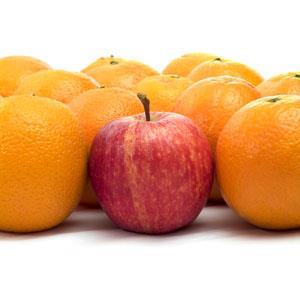Tips for teaching maths skills to our future chemists, by Paul Yates of Keele University. In this issue:quantity calculus

The IUPAC Compendium of Chemical Terminology defines quantity calculus as 'algebra with quantities where the symbols of quantities represent products of numerical values and their units'.1 Put more simply: include the units when substituting values into an equation. The word 'calculus' in this context indicates the computation of symbols, where symbols represent units. In contrast, 'calculus of variations' refers to differential and integral calculus.2
Why is it important?
The use of quantity calculus ensures that we obtain the value for any calculated quantity in the correct units. Is that temperature value in K, oC, or even oF? It also enables us to pick up mistakes in our calculations at an early stage. Consider, for example, the equation: ΔG = ΔH -TΔS relating the change, ΔG, in Gibbs free energy to changes in enthalpy, ΔH, and entropy ΔS, at temperature T. Typically ΔH will be given in kJ mol-1 and ΔS in J K-1 mol-1, and so TΔS has units of J mol-1. After practising several examples of this type students may remember to divide TΔS by 1000 to change the units to kJ mol-1. However, using quantity calculus throughout immediately shows that we will be adding J mol-1 to kJ mol-1. Remember that apples can't be added to oranges, though this example is more akin to adding apples to kiloapples.
What difficulties do students have?
If students choose the correct SI units and substitute the value of each quantity into the appropriate equation correctly then their answer will be in the appropriate SI units for that quantity. There are, however, some potential pitfalls with this approach. These include:
-
SI prefixes need to be removed and replaced by the appropriate power of 10. For example, kJ needs to be written as 103 J, and this is easily overlooked;
-
it is not always obvious what the SI unit of the final quantity should be;
-
students may not always know which units are in SI and which are not in the given data.
Generally though, students who are less confident in mathematics seem relieved to be able to come up with a number at the end of their calculation, and frequently see the inclusion of quantity calculus as an 'optional extra' which they choose to ignore. In fact, it is a mandatory part of any calculation involving physical quantities.
How is quantity calculus best taught?
Tetsuo Morikawa (Joetsu University of Education, Japan) and Brian Newbold (Université de Moncton, Canada) suggest three principles for handling physical quantities using quantity calculus:3
- each symbol denotes a physical quantity which is independent of the units in which it is expressed, eg c to represent concentration;
- the physical quantity consists of a numerical measure multiplied by the units of that measurement, eg c = 0.05 mol dm-3;
- in any expression which equates physical quantities, both the numerical measure and the units must balance, eg in the equation, where n represents amount and V volume, both sides of the equation must have units of mol dm-3.
The researchers go on to suggest that students need to practise these principles step by step. Others4 provide further insight into the third step, emphasising the difference between scientific and mathematical approaches. They stress that in science the meaning of quantities must be maintained when they are related by mathematical operations to form equations, but that this consideration does not apply in mathematics.
In the approach the third principle is the most visible; students may well have the conceptual knowledge of the first two steps but are unable to put this into practise. At the crudest level, we are asking students to deal with numbers and units separately, with the caveat that prefixes on SI units may need to be treated as numbers.
Consider a physical quantity, q, expressed as the product of numerical value a and unit u:3
q = a x u
If we have two quantities,
if q1 = q2 then it follows that a1 = a2 and u1 = u2
An example, where the numerical and unit calculations are separated, is given in the Box.
How can we make this relevant?
One way of emphasising the importance of quantity calculus is to get students to do a calculation where the units associated with the answer are not obvious. Chemistry topics such as atomic structure and spectroscopy provide many opportunities for constructing such examples around the use of frequency v, wavenumberṽ and wavelength λ as alternative expressions of an energy difference ΔE through the equations:
ΔE = hv = hcṽ
where h is Planck's constant and c the velocity of light in a vacuum. For example, given E1 = -2.178 x 10-18 J and E2 = -5.445 x 10-19 J for the hydrogen atom, we could calculate the frequency, wavenumber and wavelength as equivalent quantitative measures of the radiation associated with an electronic transition between these two levels. Doing this gives the following sets of calculations:
E = E2 - E1
= -5.445 x 10-19 J - (-2.178 x 10-18 J)
= 1.634 x 10-18 J
This is a straightforward example where we take the difference of two quantities having the same units. Note, however, that the units are included throughout the calculation.
v = ΔE/h
= 1.634 x 10-18 J/6.626 x 10-34 J s
= 2.467 x 1015 s-1
= 2.467 x 1015 Hz
The units of J cancel in the numerator and denominator of this fraction. Note that the unit Hz for frequency is equivalent to s-1.
ṽ = v/c
= 2.467 x 1015 s-1/2.998 x 108 m s-1
= 8.229 x 106 m-1
= 8.229 x 106 x (102 cm)-1
= 8.229 x 106 x 10-2 cm-1
= 8.229 x 104 cm-1
In this case the unit s-1 appears in both numerator and denominator and so cancels. Note how m is written as 102 cm and the whole conversion factor manipulated in the same way as a number.
λ= 1/ṽ
= 1/8.229 x 106 m-1
= 1.215 x 10-7 m
Here the reciprocal unit is manipulated by using the standard rules for indices.
Acknowledgements
I would like to thank the reviewers for some helpful comments.
Worked example
In this example we calculate the mean velocity, u- of an oxygen molecule at 298 K using the formula:
u- = (3RT/M)1/2
where R is the gas constant, T the absolute temperature and M the molar mass.
Begin by writing down the value of each physical quantity, including its unit:
R = 8.314 J K-1 mol-1
T = 298 K
M = 32.00 g mol-1
Identify any non-SI units, or SI units with prefixes. Although g is an SI unit, it is not one of the base units. The base unit for mass is kg.
Convert to SI units:
M = 32.00 g mol-1
= 32.00 x 10-3 kg mol-1
Substitute each value with its unit into the equation:
u- = ((3 x 8.314 J K-1 mol-1 x 298 K)/(32.00 x 10-3 g mol-1))1/2
Calculate the numerical part:
= 482
Now group together and cancel the units:
= (J kg-1)1/2
Simplify the units: (we need to be aware that 1 J = 1 kg m2 s-2). This can be deduced from definitions of force and work, or found from the tables found in many physical chemistry textbooks. Substituting into the expression in step six gives:
(J kg-1)1/2 = (kg m2 s-2 kg-1)1/2
= (m2 s-2)1/2
= m s-1
since we can treat the indices in units in the same way we would those in numbers.
Combine the numerical value and the units in the original expression to give:
u- = 482 m s-1
Finally, check that the units obtained are as expected or at least reasonable. In this case they are, since u- is a velocity.
References
- IUPAC Compendium of chemical terminology.
- M. A. White, J. Chem. Educ., 1998, 75, 607.
- T. Morikawa and B. T. Newbold, Bulgarian J. Chem. Educ., 2002, 11, 453.
- W. Dierks, J. Weninger and J. D. Herron, J. Chem. Educ., 1985, 62, 839.







No comments yet